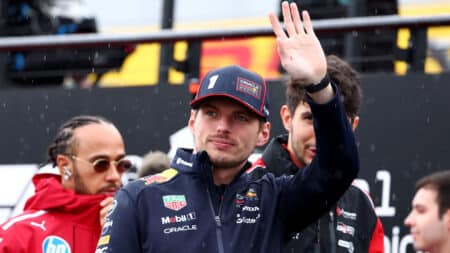
Verstappen and Wolff's 'holiday date' – will F1 champ move to Mercedes?
Keen-eyed observers have spied Max Verstappen and Toto Wolff's superyachts lined up together in Sardinia – it's the latest development in the 'Verstappen to Mercedes' rumours
Charles Leclerc withstood a two-pronged Mercedes attack to become Ferrari’s first Monza winner since 2010. Mark Hughes’ in-depth report on the 2019 Italian Grand Prix
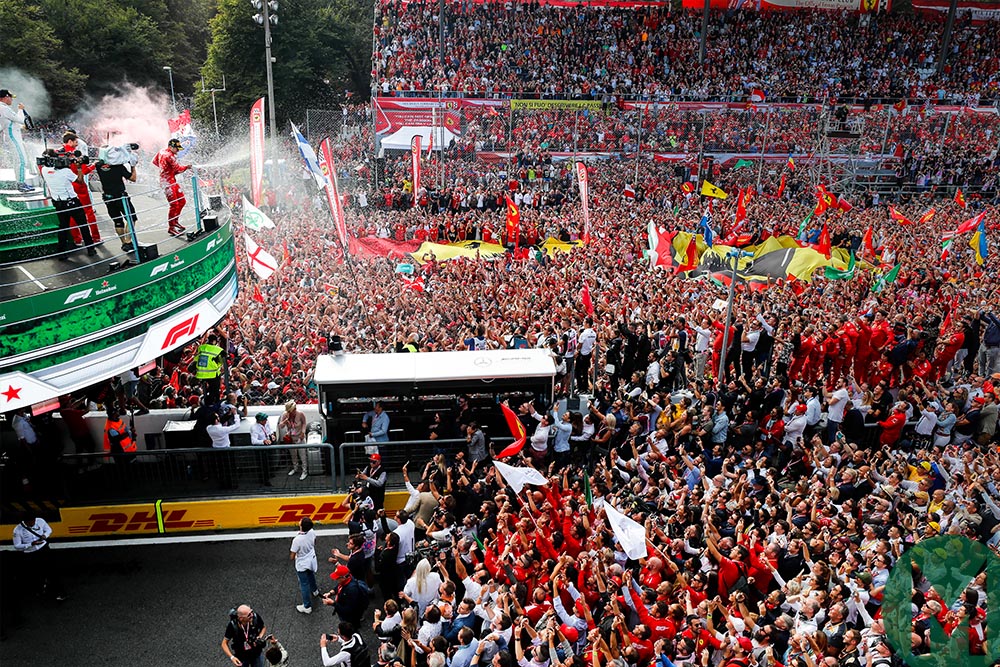
When Ferrari wins at Monza Photo: Motorsport Images
Ferrari had a better Monza weapon than Mercedes here. The SF90’s straightline speed advantage over Mercedes was huge. Enough to squeak Charles Leclerc pole and thereby have track position. But, more impressively, to leave him not under threat into Turn One even with Lewis Hamilton in full attack mode, battery loaded, DRS wide-open from right under his rear wing through Parabolica.
But that’s to take nothing away from a quite remarkable pressure drive from Leclerc. Under attack from first Hamilton, then Valtteri Bottas, virtually start-to-finish, his steeliness saw him prevail to take Ferrari’s first Monza victory in nine years.
There were a couple of critical moments where it all might have got away from him, most notably on lap 23 when he had to get physical to keep Hamilton behind up to the Roggia chicane, crowding the Mercedes out on the outside entry to the turn and forcing it partly off track. It would have been a brave race official who’d have penalised the leading Ferrari at Monza for that – but it did result in him being shown the recently-reintroduced black/white warning flag.
Vettel’s weekend was littered with errors. There is a transition of power within the team and it’s difficult to see how it can be reversed
Later, Leclerc took to the Turn One apron after braking too late and rejoined without surrendering position. Hamilton never got close enough again to force the issue as his tyres gave out before Leclerc’s resolve. Hamilton took to the full-chicaned Turn One escape road in the second stint, and so Bottas, on tyres seven laps newer than Hamilton’s, took over the attack.
There was a window of a couple of laps where it looked like the Finn’s much newer rubber could do what Hamilton’s aggression had failed to. But it was Bottas who suffered the big wobbly moment as he attacked, Leclerc who played the big point to perfection. There is a ruthless purpose behind the angelic façade, something team-mate Sebastian Vettel got to experience during the confusion of Q3 the day before and something that Mattia Binotto referenced when praising his driver’s victory drive to Italian radio, the translation being, ‘Congratulations Charles; all is forgiven.’
Vettel’s weekend spiralled further downhill after the confusion of qualifying and he spun, unassisted, out of fourth place at Ascari and received a stop/go penalty for taking out Lance Stroll as he rejoined.
It was a much closer race than Mercedes had expected it to be coming into the weekend. Given the Ferrari’s Spa qualifying advantage, it was assumed by everyone – except Ferrari – that it would be yet-stronger without the inconvenient curves of Spa’s middle sector. Ferrari knew that wasn’t going to be the case, for reasons that are making their rivals pause for thought.
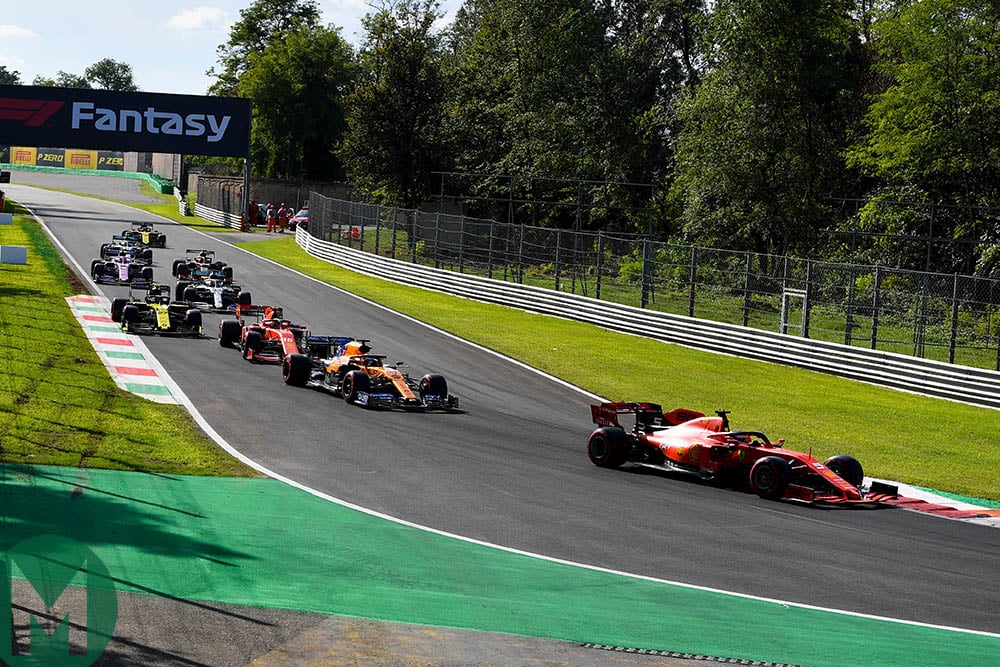
As the clock ticked down during qualifying, no driver wanted to be in front Photo: Motorsport Images
Formula One parodied itself in the final runs of Q3. Some of the brightest brains on the planet, equipped with millions of pounds-worth of sophisticated software, played a game theory version of Mexican stand-off called ‘who can go out last?’. What they hadn’t figured was that the game would continue on-track as the whole pack left together at the last moment and those at the front not wanting to be at the front drove slowly, forming a traffic blockage that caused all but one of them to be timed out by the chequered flag.
The front of the grid was thereby formed by the first runs – which put Leclerc’s Ferrari on pole, but only by the margin of four hundredths from Hamilton’s Mercedes.
“It would’ve been nice to have done that last lap and see who had the last little edge between us. For me, there was definitely more time in the car,” said Hamilton afterwards. “But I’m actually quite relieved we’re on the front row.”
Ultimately, it was all about an unintended consequence of the 2019 aero regulations. The bigger, taller rear wing obviously creates a whole lot more drag than what we had before. So the value of reducing the drag at the two tracks where long straights are the most crucial to overall lap time – Spa and Monza – has increased dramatically.
Get the Monza tow absolutely spot-on and it can now be worth as much as 0.7sec. To give perspective on that, the difference between being fastest in Q1 (Leclerc) and not making it out of Q1 (Romain Grosjean) was only 0.6sec. The slipstream boost is now too big to ignore or leave to chance or approximation. Put F1 engineers and their software onto that equation – and this happens. We know that now.
Even though a maximum out-lap time (1min 45sec) was specified, no-one broke that rule. They left the pits altogether in the order of Nico Hülkenberg, Lance Stroll, Carlos Sainz, Bottas, Leclerc, Vettel, Hamilton, Alex Albon and Daniel Ricciardo. Hülkenberg went straight on at the chicane (but that still failed to lose him the ‘lead’, so slowly were the others going), Bottas backed right off in order to get Hamilton behind him so as to tow him (it was Hamilton’s turn this weekend to choose which of them was ahead in the final Q3 runs), and by the time they arrived at the Lesmos Sainz and Hülkenberg were two-abreast, each trying to be passed by the other. Vettel — who’d realised sooner than anyone else they were running out of time and had passed Leclerc — at this moment was right behind them waving his hand urging them to get on with it, but was blocked.
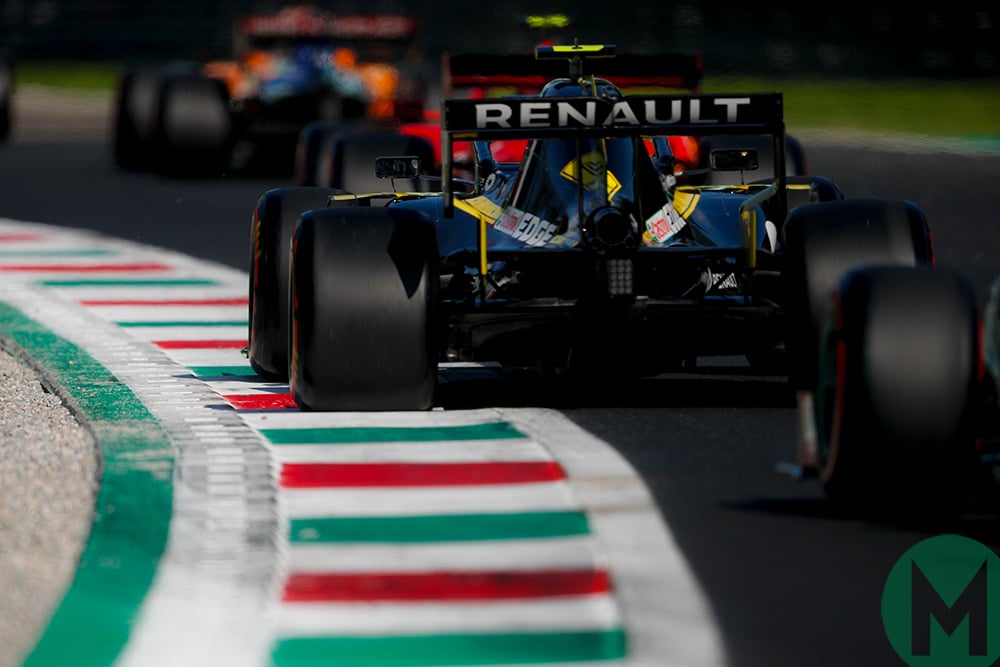
Fresh rubber and qualifying engine mode, but all too late Photo: Motorsport Images
Vettel — who had towed Leclerc to that provisional pole — was clearly animated about Leclerc, who was supposed to be returning the favour on this run but was backing off and not forcing his way through the dawdlers. Leclerc was keen to get a tow from one of them and was prioritising that more than his agreement with the team about towing Vettel to a time that might beat his own provisional pole. Seb eventually got by the Renault and McLaren but then backed off again, instructed to let Leclerc repass to give the tow. At this point Sainz repassed Vettel and was the only one to make it across the line before the chequer.
Hamilton mistakenly thought it had been the Ferrari drivers doing the blocking at the front. Vettel was furious with Leclerc and later commented: “I thought we had spoken about it. I definitely listened to what we intended to do… but we weren’t doing what we were supposed to do and that’s why it was a mess and I didn’t get a run in the end.
“I’m not entirely happy because I thought it was clear what we communicated beforehand… I was the one trying to indicate ‘Get out of the way’ because it was clear that I should be the one behind in the second run and getting a tow, because I was the first one in the first run. People were slowing down, Charles was slowing down and in the end I didn’t get across the line… The [first run] was good, the car was very good and I had a really good lap. I just had no tow. That was the difference between pole and not pole today.”
A full and frank discussion reportedly followed in the Ferrari debrief and Leclerc was held accountable. He’s had tougher things than that to deal with and, rather like Hamilton at Hungary 2007, was quite willing to graduate from grateful apprentice to a hard, seasoned pro ready to fight his own corner even at the expense of team harmony. Something very significant happened at Ferrari on Saturday.
In the aftermath of the farce, Hulk was summoned for leaving the track for no apparent reason (exonerated). He, Sainz and Stroll were summoned for driving unnecessarily slowly and later reprimanded.
All of which was a bit of a distraction from the fact that Ferrari’s one-lap pace advantage over Mercedes was not as big as had been expected. This was the car, after all, that had secured Spa pole by 0.7sec now racing around a track with the difficult bits (the corners) largely absent. It had gained over 1sec on the Mercedes down the two straight sections of Spa but lost 0.4s through the demanding twists of the middle sector.
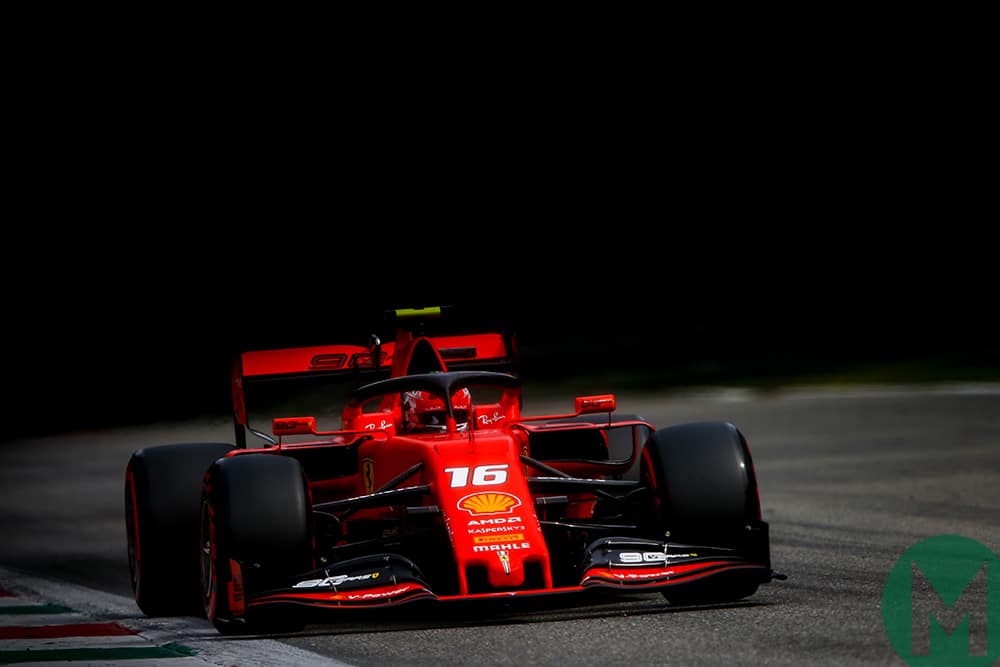
An acceleration burst at the start of straights gave Ferrari its speed advantage Photo: Motorsport Images
Monza has no really demanding twists. The Ferrari was fastest at the end of the straight by a similar extent to Spa, but it was entering those straights with a much bigger deficit than in Belgium. It was then accelerating rather harder than its rival, its power advantage particularly noticeable as a burst at the start of the straights. But that advantage could only really be used twice a lap here, whereas in Spa that burst would be used repeatedly in the middle sector, offsetting the car’s aero deficit there.
Ferrari knew it would be stronger in Spa than here. It had made a specific Monza aero package to offset the reduction in competitiveness it expected here whereas Mercedes had simply trimmed its Spa wing and so was carrying more downforce and associated drag. The power of the tow, as both giver and receiver, would have been greater with the Mercedes than the Ferrari.
The tiny margin by which Hamilton trailed Leclerc was probably accounted for by how much time the latter lost as Räikkönen spun just ahead of him as they entered Parabolica as the Alfa headed towards the tyre barriers.
Bottas, running next in line and benefitting from Hamilton’s tow, looked set for a provisional pole but by the time he arrived at Parabolica, Räikkönen’s yellow flags were out, obliging him to lift for a lap that would stand as only third fastest, albeit only 0.008sec off Hamilton. This was just 0.1sec quicker than Sebastian Vettel who verged between super-fast and error, never quite putting his ultimate lap together.
Had he been able to hook up his best sectors, he’d have been on pole by a couple of hundredths. He appeared to have all four wheels off the track at Parabolica on the lap that stood as his grid time but the stewards accepted there was room for doubt after looking at footage and stills from various angles. Had the final runs happened conventionally, there’s every chance that pole would have been fought out by Hamilton and Vettel as the two who were set to receive tows from their respective team-mates.
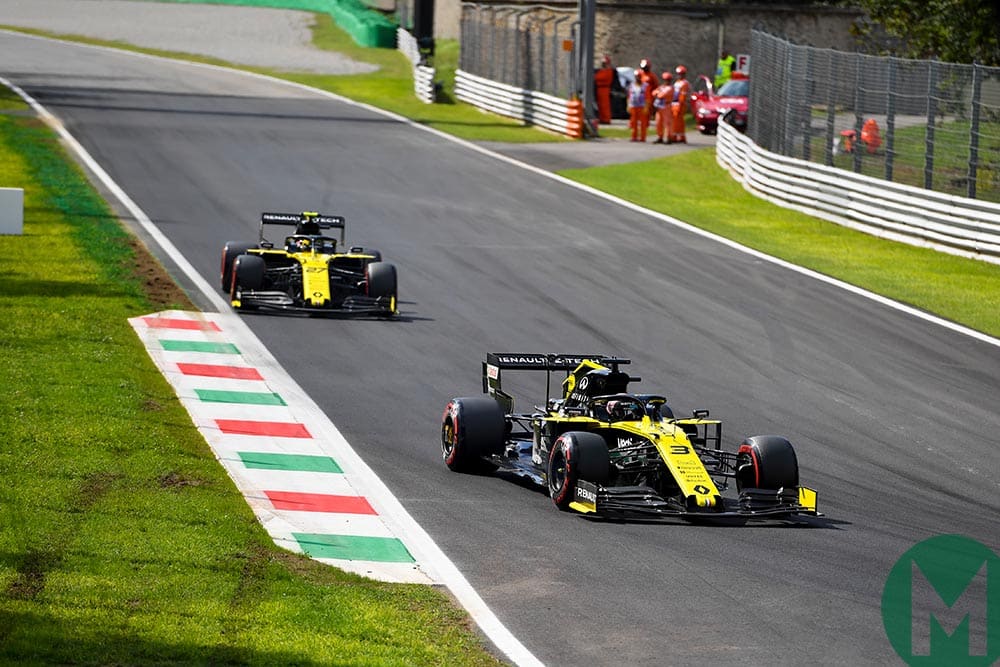
Monza suited the Renaults, which benefitted from the Q3 traffic jam Photo: Motorsport Images
Half-a-second adrift of the Ferrari/Mercedes slog-out were the Renaults, quick when the track demands a combination of straightline speed and slow corner performance, just as in Montreal and Spa. Daniel Ricciardo slotted in fifth-fastest, one place and a couple of tenths ahead of Nico Hülkenberg. Around the low-drag demands of this place, the RS19 was around 0.5sec faster than the identically-powered McLaren.
With the only lap anyone recorded on the final runs, Sainz qualified his McLaren seventh. Lando Norris knew coming in he was taking an engine penalty (because of the Spa failure) and so ran Q2 only to give Sainz the tow. His lap there put him 14th quickest but wasn’t a serious effort.
Alex Albon didn’t get in a Q3 lap at all in his Red Bull. His first attempt was thwarted by the red flags for Räikkönen’s accident. He was then in the pack that failed to make the line in time for the final effort. His sector times suggested he could have qualified in the mid-1min 19sec, which would’ve put him fifth on the grid, just behind Vettel.
“We should have taken less risk [in the timing of] the second run,” he said, “but we were fighting for a top-five position.” Max Verstappen in the sister car was taking an engine penalty for the fitment of the new Honda Spec 4. He didn’t get a lap in at all. “He experienced a spike in revs on the kerb at Turn Two,” explained Christian Horner, “which meant he felt a loss of power and as a precaution he aborted the lap.” He was allowed to start only at the stewards’ discretion. The RB15 – naturally quite a draggy car in its concept – was trimmed out in the rear wing department by an extreme degree.
Lance Stroll got his Racing Point through to Q3 on a track that always seems to suit him. Like Albon, he didn’t get a Q3 lap on the board, for exactly the same reasons, and lined up ninth. His Q2 lap was marginally quicker than the Alfas and around 0.3sec off Sainz’s McLaren. Sergio Perez was forced to pull the sister car to the side of the track in Q1 with a sudden and total lack of power, this marking the first time he hasn’t out-qualified Stroll all year. Replacing the engine put him at the back of the grid.
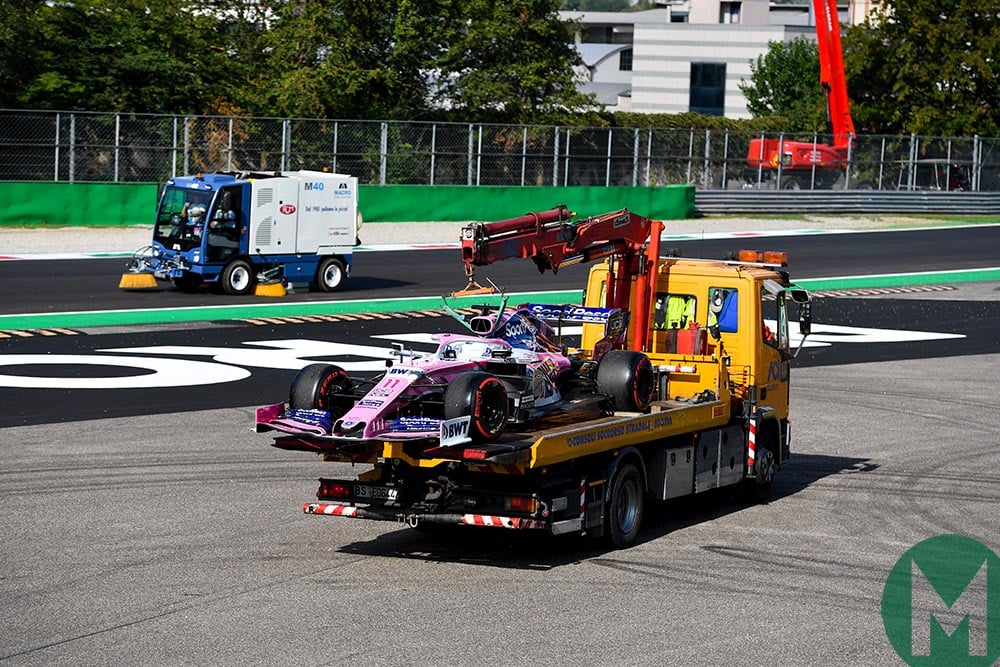
Perez lost his 100% qualifying record against Stroll after engine failure Photo: Motorsport Images
Räikkönen squeezed his Alfa into Q3 marginally ahead of team-mate Antonio Giovinazzi but his Parabolica accident came before he got a Q3 lap on the board. “I paid the price for my mistake,” he said, “which is a bit of a shame as the car was behaving pretty well.” The car went into the tyre wall backwards quite heavily and there was concern that the gearbox may have been damaged.
Giovinazzi reckoned he only lost out to his team-mate as someone had put gravel down on the exit of the Roggia chicane just ahead of him. Raikkonen’s car was rebuilt to a different spec and he’d therefore be obliged to start from the pitlane.
The Haas was very slow on the straights even if respectably quick through the turns. Kevin Magnussen got a tow for half-a-lap from Kvyat’s Toro Rosso to put him 12th fastest. Romain Grosjean went out in Q1, 0.1sec slower.
Toro Rosso didn’t get its slipstreaming act together. With Pierre Gasly taking an engine penalty (for the new Honda Spec 4 that Kvyat got in Spa), his Q2 role was primarily to tow his team-mate. But they got separated by the pack on the final Q2 runs, leaving Kvyat only 13th without a tow. Gasly was 15th.
At around 1sec off the Haas pace, the Williams were in better shape here than at Spa, with George Russell keeping intact his 100% qualifying record over Robert Kubica – by the chunky margin of 0.5sec.
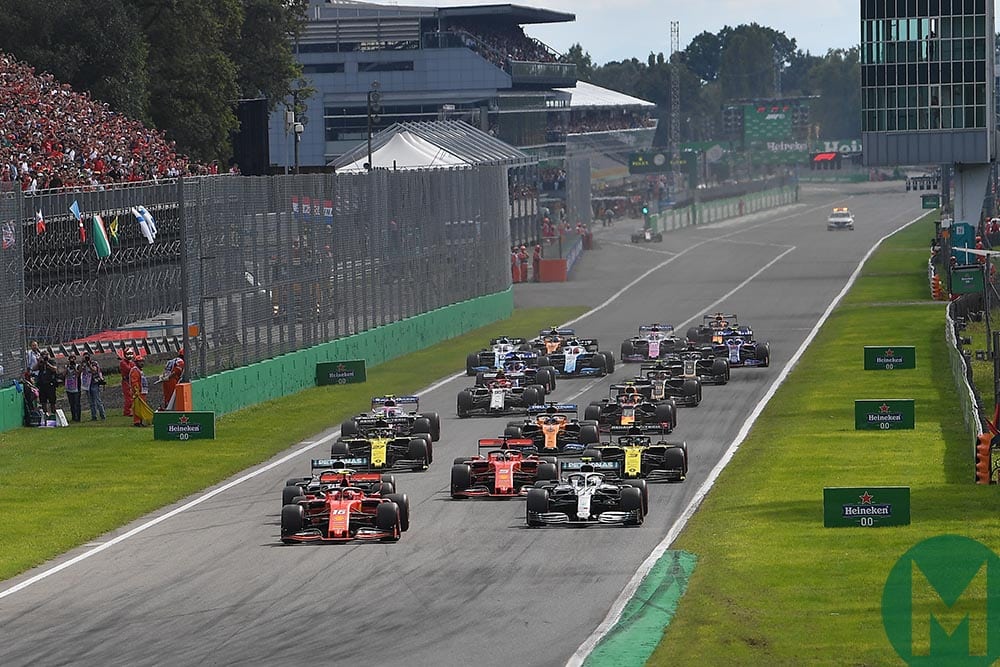
Photo: Motorsport Images
The Mercedes were faster away than the Ferraris but not by enough to counter Leclerc’s pole and the way that his car built its speed on the long run down to the first corner. Leclerc slotted in there from Hamilton, Bottas and Vettel.
Hülkenberg got a better run through the second part of the chicane than Ricciardo and passed the sister Renault clean around the outside, with Hulk then getting such a good tow from the faster cars ahead up through Curva Grande that he was able to put a successful pass on Vettel’s fourth place into the Roggia chicane.
Behind the Renaults ran Stroll, Albon, Giovinazzi, Magnussen, Kvyat, Kubica, Gasly, Russell, Grosjean (punted up the rear at Turn One and taking to the escape road), Perez, Norris and the pit lane-starting Räikkönen. Trailing around at the back with a damaged front wing was Verstappen’s Red Bull, the victim of the concertina effect into the first turn after glancing the back of Perez. Pitting for a new nose, he’d be fitted with a set of softs to help him make progress through the traffic, with a switch to another set of mediums later on.
As usual, it was nominally set to be a one-stop race. But so low were the degradation rates that the pit stop window would be open for a very long time. This meant that the overcut might work if the stop was early enough that the car staying out still had good tyres. If not, then it would have to be the undercut. Most of those outside the top 10 had a transposed strategy from the Q3 qualifiers, going for an opening stint of mediums and switching to softs. Unfortunately for him, this included Räikkönen. The relevant person at Alfa had not known the rule that as a Q3 qualifier, if he was starting in the same chassis, he was obliged to start the race with the tyres on which he’d completed Q2 – ie a set of softs – regardless of starting from the pitlane. He’d later be called in for a stop/go penalty. “I don’t have an answer,” replied Kimi when asked. “I don’t know the rules.”
Vettel had retaliated on Hülkenberg into Turn One to begin lap two, and Leclerc had got himself just out of Hamilton’s DRS reach as the feature was enabled at the end of that lap. Albon made a sensationally late move on the brakes into Roggia chicane on Sainz on the third lap but ran wide on the exit, allowing the McLaren back up the inside as they ran side-by-side towards Lesmo 1. Optimistically, the Red Bull recruit tried hanging on around the outside of the corner where two cars at full racing speed don’t really fit. Albon edged into the gravel and dropped places to Giovinazzi and Magnussen as he rejoined.
Kubica’s great positioning on the opening lap had gained him places against faster cars but they were soon past him again, the Williams very slow on the straight and Robert suffering in addition with a locking front left that eventually developed into a flat-spot which would subsequently force him onto a less-than-ideal two-stop. Team-mate Russell passed him before then and would go onto keep a couple of troubled and delayed runners behind him.
Into the fifth lap Ricciardo, having forced Hulkenberg to use his battery defensively and thereby harvest earlier down the straight, got by the sister Renault under DRS into the first chicane. Ricciardo would proceed to edge away from his team-mate.
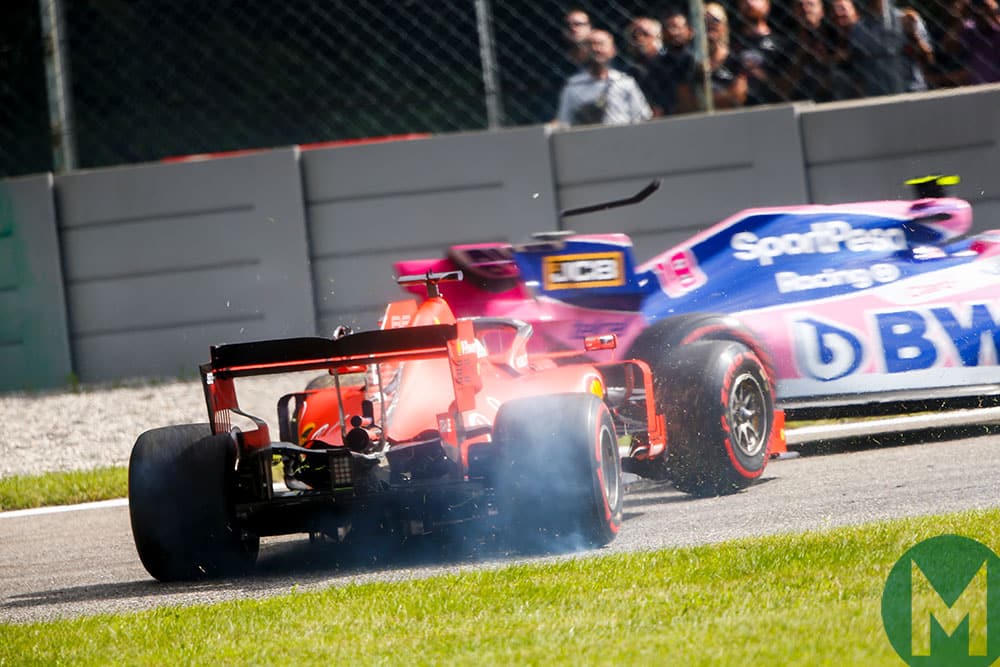
Vettel hits Stroll as he attempts to rejoin the track, following a spin Photo: Motorsport Images
Vettel meanwhile was beginning to put pressure on Bottas’ third place, having got to within DRS range at the end of the fifth lap. Through Ascari he was pushing hard so as to get an exit good enough to benefit fully from Bottas’ slipstream – but he pushed just a little too hard and the Ferrari spun to the inside onto the grass and the Renaults passed by.
Without being able to turn his head at the acute angle required to see what might be coming from the left, Vettel rejoined – into the path of Stroll’s Racing Point. Lance steered around as best he could but his rear wheel caught Vettel’s front wing – and he too spun. Gasly arrived on the scene but in steering around the Ferrari found himself on-course for Stroll’s broadside car and had to take to the gravel in avoidance, losing a couple of places.
Vettel pitted for a new nose, rejoining at the back and would be awarded a stop and go penalty for causing a collision and rejoining in an unsafe manner, putting him totally out of contention. These are troubling times for the former champion and it was tempting to rewind back to events of Q3 on Saturday and what might have happened had Leclerc towed him to pole (which looked entirely feasible prior to the stand-off farce). That aside, his weekend was littered with errors big and small, just as Leclerc is coming into full ascendancy. There is a transition of power within the team and it’s difficult to see how it can be reversed. Stroll would be given a drive-through for the way he rejoined the track.
Meanwhile Perez in the other Racing Point was making good progress from the back. The Vettel/Stroll/Gasly incident had brought him three places and he was now running 11th, close behind the Giovinazzi/Magnussen/Albon/Kvyat train which was rather falling away from Sainz who, in turn, couldn’t keep up with the Renaults. Albon would soon enough find a way past Magnussen (by missing out part of the second chicane, for which he’d be given a 5sec penalty) and Giovinazzi would be chasing down Sainz once more, though there were a few ragged moments along the way. K Mag was struggling with the usual Haas loss of race pace and was picked off by Kvyat, the Toro Rosso flying along and soon catching Giovinazzi and lapping at much the same pace as Albon. Next on Magnussen’s case was Perez, a dice that got a little fraught at times.
Those Renaults being much more competitive than usual played a significant part in the shaping of the race, for it meant that Leclerc, Hamilton and Bottas (with just 3sec between the trio by the 15th lap) were not pulling away from the lead of ‘Class B’ as quickly as usual. Because it was taking significantly longer to establish a pit stop’s-worth of gap over the Renaults to drop into, Mercedes’ hopes of trying to overcut past Leclerc were beginning to fade along with Hamilton’s tyres.
Passing the Ferrari on-track wasn’t looking feasible simply on account of its big straightline speed advantage. Even when Hamilton was close enough to get DRS (which is only worth around 4-5km/h here on account of the skinny wing rather than the usual 13-14km/h), he was never really within out-braking range by the end of the pit straight. It wasn’t just drag either – it was sheer grunt, particularly noticeable out of the chicanes. Leclerc was playing his powerful hand very coolly. “Even when he had DRS I was just making sure I had some modes to defend.”
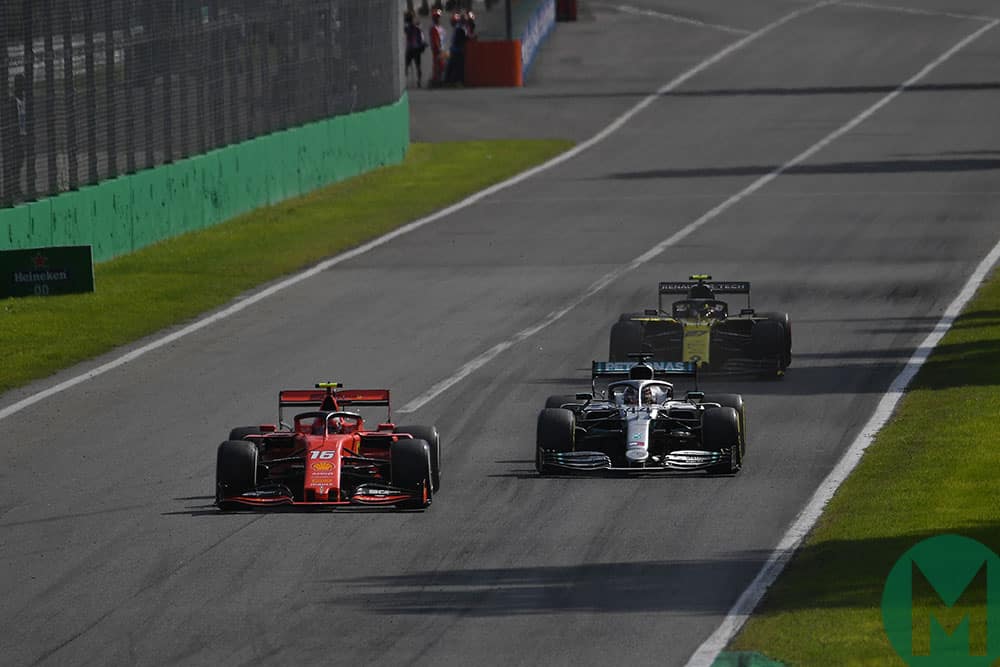
Hamilton was never close enough going into Turn One Photo: Motorsport Images
“I’m not going to be able to overcut,” reported Hamilton as the pit window approached. “The tyres are going.” A lap or so later he reported, “He’s quicker than us now.” At this time Hamilton was only around 15sec and 20sec clear of Ricciardo and Hulkenberg respectively and a stop would take 23sec. Mercedes brought Hamilton in from 1.5sec behind Leclerc for an undercut attempt on the Ferrari. This was lap 19.
How would Hamilton have dealt with that situation if the title had already been in the bag? “I wouldn’t have moved and we’d have crashed”
He was onto his new mediums and underway again in 2.6sec as Leclerc was instructed to give it everything and pit on the next lap. His in-lap was 0.6sec quicker than Hamilton’s, the Ferrari stop was 0.3sec quicker. Combined, it allowed Leclerc to come out still just out of Hamilton’s out-braking range into the first turn. Leclerc was on the hard tyres, Ferrari having not enjoyed the mediums on Friday. Mercedes was hoping they’d be slower to warm up – but Leclerc was managing just fine. “It was a busier second stint,” he allowed. “The first stint was quite controlled. The second I was having to focus all the time on the car behind.”
They were both behind the Renaults and just ahead of Sainz. As they caught Hülkenberg into the Parabolica at the end of the 22nd lap, Leclerc forced his way inside and ran through there wheel-to-wheel. Was this going to delay Leclerc sufficiently for Hamilton to finally get a run on him? Hamilton entered the straight tight in Hülkenberg’s slipstream, DRS wide open, but could barely grind past. Eventually he did so and slalomed from the inside to outside of the track into the braking area, but Leclerc had him covered there.
The crowd was roaring its approval, but Hamilton wasn’t finished yet. Hard on Leclerc’s tail out of the chicane, using the medium tyre’s better traction to offset the Ferrari’s greater grunt, he was almost touching as they ran flat-out through Curve Grande. Hamilton feigned one way, Leclerc blocked. Hamilton moved to the outside approach to the Roggia chicane and Leclerc ruthlessly crowded him out. Hamilton, chasing the championship, was desperate to keep from damaging his car and the Merc took to the grass and kerbing to avoid contact. He rejoined from the run-off area still behind. Now the crowd was going crazy with delight. “He didn’t leave me a car’s width there,” radioed Hamilton. “He drove me off the circuit.”
On the next lap Leclerc was shown the black and white ‘bad sportsmanship’ flag, as a warning not to repeat. How would Hamilton have dealt with that situation if the title had already been in the bag? “I wouldn’t have moved and we’d have crashed,” he replied.
Related content
Leclerc and Hamilton passed Ricciardo without incident on the following lap, the dice now at stalemate for the time being. Mercedes though had left Bottas out there and would do for some time yet. He was under no undercut pressure from behind (thanks to Vettel’s spin) and so the idea was to run him as long as feasible so as to maximise the new tyre grip advantage after he did eventually stop. In this way, Mercedes had a two-pronged attack on the lone Ferrari. Bottas’ stop came on the 27th lap, meaning his new mediums were seven and eight laps newer respectively than the tyres of Leclerc and Hamilton. He rejoined in between the yet-to-stop Renaults, 7.5sec behind the nose-to-tail Leclerc/Hamilton but soon lapping significantly faster, once he’d cleared Ricciardo.
Sainz pitted from sixth on the 27th lap but a cross-threaded wheelnut meant his front-right came loose as he drove down the pitlane, obliging him to pull the McLaren to the side. The race was put under a Virtual Safety Car to clear it off the track, which allowed Kvyat, Perez and Gasly to get very time-cheap pit stops. It was unfortunate timing for both Red Bulls, which had pitted moments before the VSC.
Verstappen had made steady progress from his first lap mishap, having rejoined 25sec behind the back of the pack. He’d caught up with Perez by the 26th lap and so had pitted for the undercut. The VSC that Perez was able to pit under ensured the Racing Point stayed ahead. Similarly for Albon, who’d just been about to catch Sainz and had pitted for the undercut. The VSC allowed Kvyat to jump ahead – but that came to mean nothing a lap later as the Toro Rosso pulled off with a sudden loss of power. It was a disappointing end to a great drive from Kvyat, who’d likely have been fighting Albon for sixth otherwise. That retirement triggered another VSC.
The order behind the Renaults was now: Giovinazzi (who had undercut up the order with an early stop but would soon be running out of grip), Albon, Magnussen (soon to retire with no hydraulics), Perez, Norris, Gasly, Verstappen and Stroll.
On each of the restarts, Leclerc went relatively unchallenged by Hamilton, who came in and out of DRS range according to where each was using their battery. Hamilton would try to force Leclerc to use up his electrical power to defend while not using his own – ready to unleash it when Leclerc’s battery was depleted. But the Ferrari’s system was working very efficiently, helped by the mechanical grunt and low drag. They came to lap the delayed Vettel on the 31st lap but Seb pulled aside for both of them without favour for either.
By the 33rd lap Hamilton was complaining, “I need more power,” by way of asking for a more aggressive engine mode with which to attack the otherwise impenetrable barrier of the Ferrari. But that wasn’t granted. Mercedes was back to full planned power (after running slightly conservatively at Spa) but wasn’t about to risk going beyond its planned usage. And as Hamilton’s challenge began to fade with his tyres from running tight in the turbulence for lap after lap, so Bottas was edging closer to them.
Into lap 36, Leclerc locked up into the first chicane and was forced to take the apron that snips the last little bit of the turn off. He rejoined the track still in front of Hamilton and the power advantage was enough to keep him out of Hamilton’s reach. Lewis had one last attack from the Parabolica on the 38th lap but was thwarted just as before. At this point he declared he’d run out of tyre life.
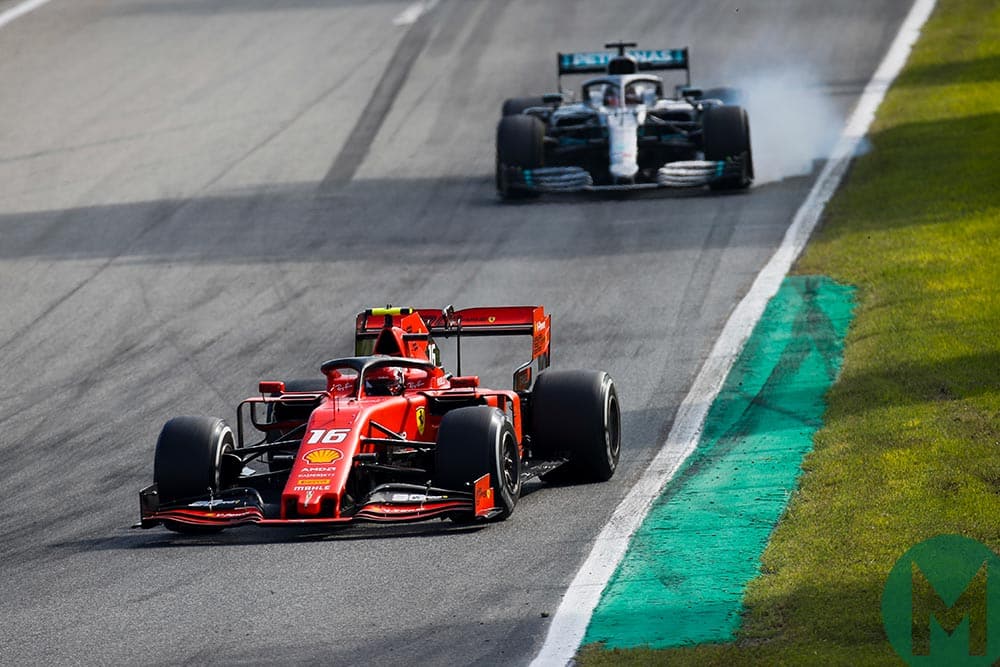
Hamilton lock-up signalled a new opponent for Leclerc Photo: Motorsport Images
Bottas was just getting within Hamilton’s DRS range when the latter locked up into turn one and was obliged to take the full run-off and its coned chicane – meaning Bottas was now up to second place, as if in a relay race to apply maximum, unrelenting pressure upon Leclerc.
Ricciardo and Hulkenberg, by contrast, were having serene races in fourth and fifth about half-a-minute off the lead. Behind them, Albon passed Giovinazzi and began to close on Hulkenberg. Verstappen had, for the second time, caught up with Perez and found himself unable to pass because of the Racing Point’s strong straightline speed and a rev limiter glitch on the Red Bull. They would continue their dice after each passing Giovinazzi.
Urged on by his engineer, Bottas had closed to within 1sec of Leclerc by the 45th lap, with just eight to go. But Leclerc was equal to the pressure, even though the Ferrari was now beginning to slide noticeably under power out of the chicanes. “Yes, there was a drop-off of grip from all four tyres and I was struggling a little bit with front locks,” confirmed Leclerc, “and towards the end I started to lose the rear, and that’s where the performance started to… where I started to slow down a little bit. They were not in a very bad shape. I believe they could have stayed where they were for quite many laps still – but yeah, I was just struggling with the rear left especially.”
But each time Bottas got close, he’d find it very difficult not to lock his front tyres as the Ferrari robbed him of downforce. “Lewis can somehow manhandle the car close behind another and still stay close,” observed Toto Wolff. “It’s something Valtteri needs to work on.” Bottas had a big twitchy moment through Ascari on the 46th lap, giving Leclerc half-a-second of breathing space.
Two laps later, squeezing past Gasly to lap him before the first turn, Bottas ran a little too deep into there and was forced onto the run-off apron, losing him another chunk of time. Leclerc had just been given another break. Hamilton meanwhile, with his right-front badly blistered, pitted for a set of soft tyres on which he would try for the fastest lap and the associated point. It was a feat he achieved with relative ease.
Bottas closed back up to Leclerc before locking up again into Turn One, this time while lapping 10th-placed Norris. He never stopped trying — the Mercedes really charging along – even getting into another big moment through Ascari on the final lap. “Gutted,” was his summary after taking the flag second, with Hamilton non-plussed in third, well clear of the delighted Renault men Ricciardo and Hülkenberg, with Albon not quite able to catch the latter before the end after a race of some adventure.
Perez’s seventh place from the back of the grid represented a typically tenacious performance, fending off the delayed Verstappen to the end. Giovinazzi was delighted to get a couple of points for his day’s endeavours, ahead of Norris.
Leclerc’s second victory in seven days put him in a very select club of Ferrari drivers victorious at Monza – and it was quite possibly the most hard-fought and pressured of all of them. The delight and wonder on his 21-year-old face was real. But there is hard-man steel beneath the boyish looks. He saw off his team-mate on Saturday and Lewis Hamilton on Sunday, neither of them by gentle means. As he forces his way into the elite, there’s bound to be some bruising.
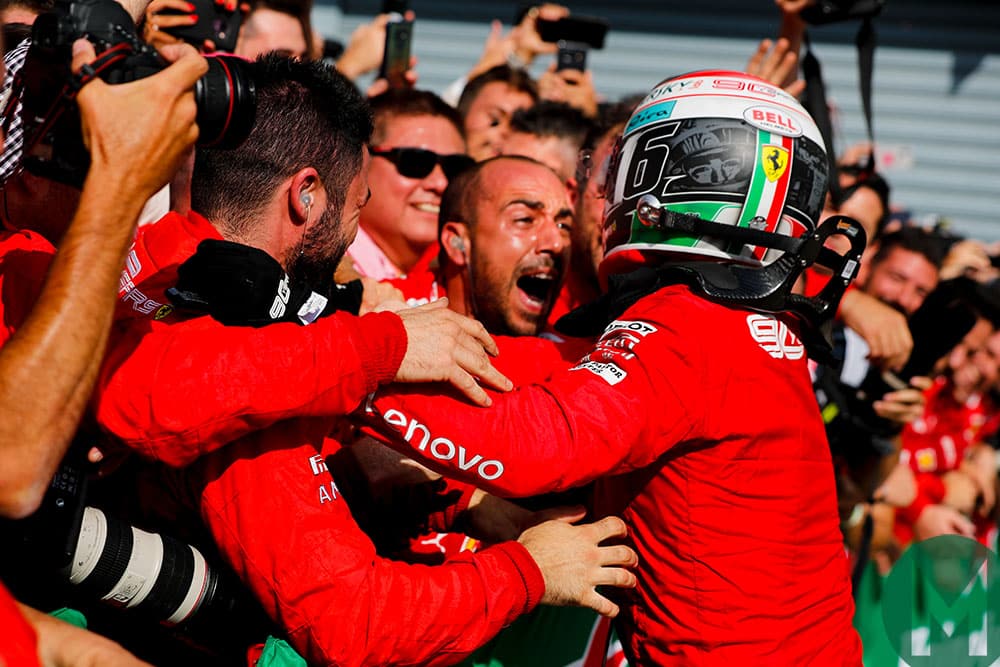
Photo: Motorsport Images
| Position | Driver | Team | Time | Points |
|---|---|---|---|---|
| 1 | Charles Leclerc | Ferrari | 1hr 15min 26.665sec | 25 |
| 2 | Valtteri Bottas | Mercedes | +0.835sec | 18 |
| 3 | Lewis Hamilton | Mercedes | +35.199sec | 16* |
| 4 | Daniel Ricciardo | Renault | +45.515sec | 12 |
| 5 | Nico Hülkenberg | Renault | +58.165sec | 10 |
| 6 | Alex Albon | Red Bull | +59.315sec | 8 |
| 7 | Sergio Perez | Racing Point | +1min 13.802sec | 6 |
| 8 | Max Verstappen | Red Bull | +1min 14.492sec | 4 |
| 9 | Antonio Giovinazzi | Alfa Romeo | +1 lap | 2 |
| 10 | Lando Norris | McLaren | +1 lap | 1 |
| 11 | Pierre Gasly | Toro Rosso | +1 lap | |
| 12 | Lance Stroll | Racing Point | +1 lap | |
| 13 | Sebastian Vettel | Ferrari | +1 lap | |
| 14 | George Russell | Williams | +1 lap | |
| 15 | Kimi Räikkönen | Alfa Romeo | +1 lap | |
| 16 | Romain Grosjean | Haas | +1 lap | |
| 17 | Robert Kubica | Williams | +2 laps | |
| DNF | Kevin Magnussen | Haas | ||
| DNF | Daniil Kvyat | Toro Rosso | ||
| DNF | Carlos Sainz | McLaren |
*Fastest lap
| Position | Driver | Team | Points |
|---|---|---|---|
| 1 | Lewis Hamilton | Mercedes | 284 |
| 2 | Valtteri Bottas | Mercedes | 221 |
| 3 | Max Verstappen | Red Bull | 185 |
| 4 | Charles Leclerc | Ferrari | 182 |
| 5 | Sebastian Vettel | Ferrari | 169 |
| 6 | Pierre Gasly | Toro Rosso | 65 |
| 7 | Carlos Sainz | McLaren | 58 |
| 8 | Daniel Ricciardo | Renault | 34 |
| 9 | Alexander Albon | Red Bull | 34 |
| 10 | Daniil Kvyat | Toro Rosso | 33 |
| 11 | Nico Hülkenberg | Renault | 31 |
| 12 | Kimi Räikkönen | Alfa Romeo | 31 |
| 13 | Sergio Perez | Racing Point | 27 |
| 14 | Lando Norris | McLaren | 25 |
| 15 | Lance Stroll | Racing Point | 19 |
| 16 | Kevin Magnussen | Haas | 18 |
| 17 | Romain Grosjean | Haas | 8 |
| 18 | Antonio Giovinazzi | Alfa Romeo | 3 |
| 19 | Robert Kubica | Williams | 1 |
| 20 | George Russell | Williams | 0 |
| Position | Team | Points |
|---|---|---|
| 1 | Mercedes | 505 |
| 2 | Ferrari | 351 |
| 3 | Red Bull | 266 |
| 4 | McLaren | 83 |
| 5 | Renault | 65 |
| 6 | Toro Rosso | 51 |
| 7 | Racing Point | 46 |
| 8 | Alfa Romeo | 34 |
| 9 | Haas | 26 |
| 10 | Williams | 1 |

Keen-eyed observers have spied Max Verstappen and Toto Wolff's superyachts lined up together in Sardinia – it's the latest development in the 'Verstappen to Mercedes' rumours
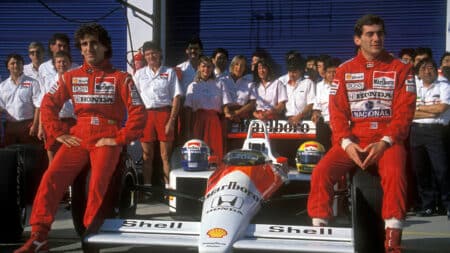
Ayrton Senna and Alain Prost were more concerned about losing ground to the other than taking a risk to maximise their own performance, says McLaren designer Neil Oatley in a new Motor Sport interview
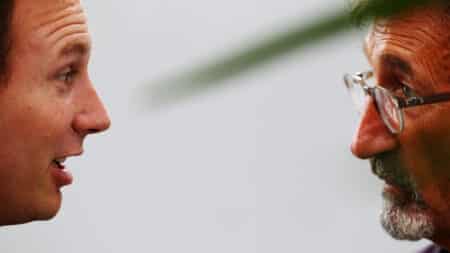
Christian Horner has now left Red Bull, the last of a certain breed of F1 team principal
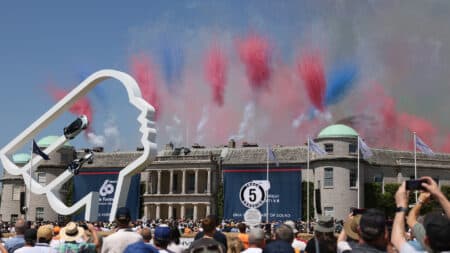
From Formula 1 icons to futuristic tech and lots of action, here are seven things not to miss at the 2025 Goodwood Festival of Speed